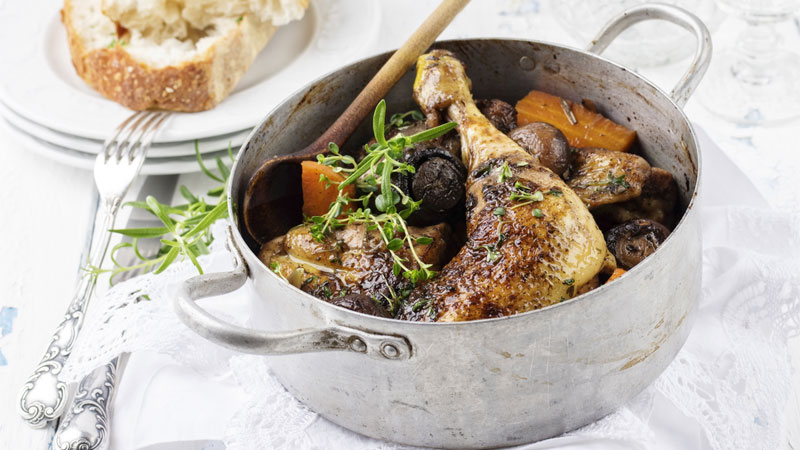Daniel Boulud recalls cooking coq au vin (a “sublime French country classic”) during his spell at the iconic Burgundian restaurant La Mère Blanc in the 1970s. Every day at 10 a.m., local farmers would enter, sit at the bar, and order a plate of the hearty regional stew. “For them,” he says, it was just a snack — “a casse-croute.”
As modern diets go, this dish is anything but a snack. In its classical preparation, coq au vin is served with the same rich garnish as France’s other iconic meat and wine mash-up: boeuf bourguignon. Bobbing inside a simmering sauce of chicken stock and wine, you’ll find smoky pancetta lardons, handfuls of button mushrooms, and sweet pearl onions.
The name coq au vin translates to “rooster in wine,” though nowadays it’s commonly prepared with chicken instead of rooster. Swapping out the dish’s other named ingredient, however, might raise some eyebrows. Can you prepare a chicken stew with white wine and still call it coq au vin?
Purists might shudder at the thought, but it actually makes a lot of sense to reach for a bottle of white instead of red. When pairing meat with wine, especially for cooking, common practice dictates that red wine accompanies red meat and white wine pairs with white meat and fish.
In France, however, where regional cooking revolves around local delicacies, such practices are overlooked. “The wine used to make coq au vin changes depending on the region in France,” Alsatian chef Gabriel Kreuther tells VinePair.
Order coq au vin in a region known for its red wines, he says, and you’ll encounter the very same dish the rest of the world knows. But order in a region like Alsace, and you’ll find your chicken marinated and cooked in a zesty local white.
Alsatian coq au vin utilizes the region’s dry Riesling wines and is sometimes referred to as coq au Riesling. Apart from the wine used, the preparation of coq au Riesling is very much the same as “traditional” coq au vin, with just a few differences.
Marinating chicken in white wine is optional but not essential, Kreuther says. Historically, wine was used to tenderize tough rooster meat. The roosters used in the dish would be two or three years old and weigh 7 or 8 pounds, Kreuther explains, compared to the 12-week-old poultry we find in supermarkets today.
When serving coq au Riesling, the garnish remains the same as coq au vin, but the sauce is much lighter in color and typically finished with cream, though “one or two spoons of sour cream is better, in my opinion,” Kreuther says, “because it has natural acidity and it’s lighter.”
Rather than serve with rich mashed potatoes or crusty French loaf, consider “a very nice linguine, cooked al dente,” he suggests, or a barley risotto during winter months.
In the Jura region, located 200 miles southwest of Alsace, coq au vin incorporates neither vin blanc nor vin rouge, but instead vin jaune. The region’s famous oxidative “yellow” wines have a strong savory profile, similar to dry sherry. This region’s version of the dish typically also includes two luxurious ingredients: morel mushrooms and poulet de Bresse (Bresse chicken).
Besides holding AOC certification and being considered the finest quality poultry money can buy, Bresse chicken is prized in France because the white chicken’s appearance matches the colors of the French flag — blue legs, white body, and red crown.
Wherever you are in the country, and whichever version of the dish you’re cooking and eating, the key is to embrace local ingredients. For coq au Riesling, Kreuther recommends a Riesling “with high acidity, but not too sweet; and lots of minerality.” Hugel & Fils “Gentil” is an ideal example of such a wine, he says. It carries an average price of $14 and benefits from nationwide distribution. Alternatively, consider Sylvaner, an underrated white variety grown throughout Alsace.
Coq au Riesling
Serves 6 to 8
Ingredients:
- 1 tablespoon olive oil
- 8 ounces pancetta, unsmoked, cut into ¼-inch by 1-inch batons (these are called lardons)
- 2 large chickens, roughly 3 ½ pounds each, cut into 4 breasts, 4 thighs, and 4 legs
- 2 large onions, chopped
- 2 pounds carrots, peeled and roughly chopped
- 2 pounds celery, roughly chopped
- 6 cloves garlic, minced
- 2 bottles dry Riesling
- 2 tablespoons flour
- Bouquet garni (thyme, bay leaf, and parsley, tied together with string)
- 2 tablespoons unsalted butter
- 4 pounds button mushrooms, cut in half
- 1 pound pearl onions, peeled
- 2 tablespoons cornstarch (optional)
- 4 tablespoons sour cream
- Salt and pepper, to taste
Directions:
- Place both bottles of wine and half of the onions, carrots, celery, and garlic in a large pan. Bring to a boil, and then remove from heat. This will burn off the alcohol content and start to infuse the wine with the flavor of the vegetables.
- As the wine cools, carve the chickens: You want four breasts with ribs, four thighs, and four legs. Do not remove the breast meat from the rib cage; keeping it on the bone adds flavor and helps retain moisture during cooking. Retain the carcass and wings; you’ll use them in the stew to add flavor. When your wine and vegetables have cooled, add the chicken meat, and marinate overnight.
- The next day, heat one tablespoon of olive oil in a large pan or Dutch oven. Add pancetta and cook over medium heat until crispy. Remove with a slotted spoon and set aside on a plate lined with paper towels.
- Remove the chicken from white wine. Pat it dry and season with salt, pepper, and flour (this will help to crisp the skin).
- Increase the heat to medium-high and sear the chicken, skin side down, in pancetta fat. Do this in batches, making sure not to crowd the pan. When you’re cooking the breast meat, be sure to sear both sides, even though the rib cage has no skin. This will lock in moisture. Remove each batch when the skin is golden brown and crispy.
- Sear the carcass and wings and remove when golden brown and crispy.
- Add the onions, carrots, and celery to the pan and sauté over medium heat for 10 minutes until all are golden and soft. Add the garlic and sauté another minute.
- Add all the chicken parts and cook over medium-high heat for one minute. Use a wooden spoon to scrape the bottom of the cooking pot, making sure nothing burns or sticks.
- Add white wine to the pan and deglaze. Add some water if the wine doesn’t completely cover the chicken. Bring to a slow boil, add your bouquet garni, cover with a lid, and cook over a low heat so that the stew is gently simmering.
- While the meat cooks, heat a large sauté pan over medium heat and add 1 tablespoon butter. When hot, add the mushrooms in batches (as with the chicken, you don’t want the pan to become overcrowded). Season with salt and pepper and cook until golden. Remove from the pan, set aside, and repeat until all mushrooms are cooked. Repeat this process with pearl onions.
- After approximately 1 to 1 ½ hours of simmering, the chicken will be cooked through and tender at the bone. Remove the chicken using tongs and add to a fresh pan with pancetta, mushrooms, and pearl onions. Strain the sauce into this pan, removing the vegetables, bouquet garni.
- Bring the pot to a simmer on the stovetop. If the sauce is still very thin at this point, you can thicken using a mixture of cornstarch and water. Make a paste using 2 tablespoons of cornstarch and 2 tablespoons of cold water. Slowly add this paste to your sauce, whisking to make sure it doesn’t clump. Gently cook for 10 minutes.
- Finish the sauce with the sour cream, and season with salt and pepper to taste. Serve with a sprinkling of chopped parsley and a side of al dente linguine or pearl barley risotto.

